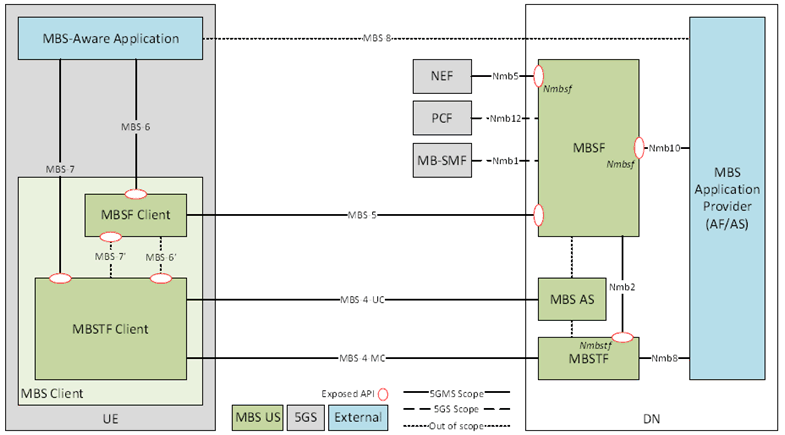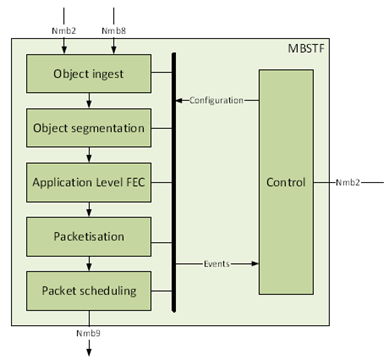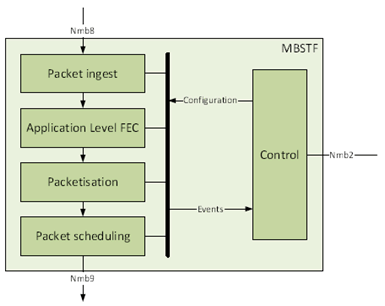Content for TS 26.502 Word version: 17.3.0
4.3 Functional entities
4.3.1 General
4.3.2 MBSF
4.3.3 MBSTF
4.3.4 MBS AS
4.3.5 MBS Client
4.3.6 MBS-Aware Application
4.4 Reference points and interfaces
...
...
4.3 Functional entities p. 13
4.3.1 General p. 13
The MBSF and MBSTF offer service layer functionality for sending data via MBS Sessions. The MBSF (clause 4.3.2) offers control plane functionality while the MBSTF (clause 4.3.3) offers user plane functionality. The MBSTF acts as a User Plane anchor when it sources IP multicast traffic. Reference point Nmb2 provides the means for the MBSF to configure the delivery methods in the MBSTF.
Figure 4.3.1-1 shows the complete set of functional entities involved in supporting MBS User Services when the MBS Application Provider is deployed in the Trusted DN, including client functions in the UE.

In the above architecture, MBS-specific functions such as the MBS AS and MBSF are shown as independent and standalone. In deployments, they may be co-located on physical devices with other functions. As an example, the MBS AS may be hosted in the MBS Application Provider domain, or it may be hosted in a 5GMS AS.
4.3.2 MBSF p. 14
The functionality of the MBSF is defined in clause 5.3.2.11 of TS 23.247. It receives provisioning and control commands either directly at reference point Nmb10 or at reference point Nmb5 (via the NEF). The MBSF invokes MBS Session operations on the MB-SMF at reference point Nmb1. The MBSF configures the MBSTF at reference point Nmb2.
The User Service Announcement function of the MBSF provides session access information which is consumed by the MBS Client and subsequently used to discover and initiate the reception of one or multiple MBS User Services. The session access information may contain information for presentation to the end-user, as well as application parameters used in generating service content for consumption by the MBS Client.
The present document defines additional Control Plane functionalities of the MBSF to support MBS User Services including:
- Generating the User Service Announcement for each MBS Session.
- Managing User Service Announcement updates.
-
Providing the User Service Announcement information to the MBS Client in a timely manner using one or more of the following mechanisms:
- Unicast User Service Announcement via reference point MBS-5, including the possible use of push- or notification-based update mechanisms.
- User Service Announcement via an MBS Distribution Session at reference point MBS-4-MC, optionally in the same MBS Distribution Session as the content it is advertising, or else via a dedicated MBS Distribution Session managed by the MBSF called the MBS User Service Announcement Channel.
- User Service Announcement via application-private means at reference point MBS-8.
4.3.3 MBSTF p. 14
4.3.3.1 General p. 14
The functionality of the MBSTF is defined in clause 5.3.2.12 of TS 23.247. It receives User Plane data traffic at reference point Nmb8 and sends MBS data packets to the MB-UPF via reference point Nmb9.
The present document defines additional User Plane functionalities of the MBSTF to support MBS User Services as follows:
- Receiving MBS Distribution Session configurations from the MBSF at reference point Nmb2.
- Sending notification events to the MBSF, e.g. data ingest failure, session terminated, delivery started via reference point Nmb2.
-
Based on the MBS Distribution Session configuration:
- MBS delivery of ingested objects or sequences of objects to the MBS Client using the Object Distribution Method (see clause 6.1). This may be used to support real-time distribution of media segments (as special objects) including CMAF segments.
- MBS delivery of ingested packet streams to the MBS Client using the Packet Distribution Method (see clause 6.2).
- Delivery of MBS User Service Announcement information (including updates as necessary) within the MBS Session.
4.3.3.2 MBSTF subfunctions to support Object Distribution Method p. 15
The MBSTF subfunctions supporting the Object Distribution Method are depicted in Figure 4.3.3.2-1 below.

Figure 4.3.3.2-1: MBSTF architecture overview for Object Distribution Method
(⇒ copy of original 3GPP image)
(⇒ copy of original 3GPP image)
The Object ingest subfunction supports:
- Pull-based ingest at reference point Nmb2: The Object ingest subfunction in this case fetches one or more objects from the MBSF using HTTPS for inclusion in the MBS User Service Announcement Channel.
- Push-based ingest at reference point Nmb2: The Object ingest subfunction receives one or more objects from the MBSF using HTTPS for inclusion in the MBS User Service Announcement Channel.
- Pull-based ingest at reference point Nmb8: The Object ingest subfunction in this case fetches one or more objects from the MBS Application Provider (AF/AS) using HTTPS.
- Push-based ingest at reference point Nmb8: The Object ingest subfunction receives one or more objects from the MBS Application Provider (AF/AS) using HTTPS.
4.3.3.3 MBSTF subfunctions to support Packet Distribution Method p. 16
The MBSTF subfunctions supporting the Packet Distribution Method are depicted in Figure 4.3.3.3-1 below.

Figure 4.3.3.3-1: MBSTF architecture overview for Packet Distribution Method
(⇒ copy of original 3GPP image)
(⇒ copy of original 3GPP image)
The Packet ingest subfunction supports the reception of a packet sequence at reference point Nmb2 from authorized sources.
The optional Application Layer FEC subfunction to support object recovery when some packets are not received by the MBMS Client.
The Packetisation subfunction places the ingested packets (and, optionally, the FEC data) into Nmb9 transmission packets. Depending on the transmission mode, ingested packets may be reformatted suitable for MBS transmission.
The Packet scheduling subfunction schedules the outgoing data stream according to target bit rate configuration.
The Control subfunction offers support for MBSTF service configuration and service notifications at reference point Nmb2.
4.3.4 MBS AS p. 16
The MBS AS performs the following functions to support MBS User Services:
- Providing a byte-range file repair service to the MBSTF Client (via reference point MBS-4-UC) for use with the Object Distribution Method.
4.3.5 MBS Client p. 17
The MBS Client function is part of the UE. The functionality of the UE is defined in clause 5.3.2.8 of TS 23.247.
The MBS Client is further divided into the following subfunctions:
- MBSF Client: Communicates with the MBSF on MBS User Service control aspects.
- MBSTF Client: Communicates with the MBSTF or MBS AS in order to provide an MBS Application Data Session to the MBS-Aware Application.
- Reception of IP multicast data from either a Multicast MBS Session or a Broadcast MBS Session.
- Exposure of MBS Application Data Sessions towards an 5MBS-Aware Application.
- Using AL-FEC to recover packets or objects , if this optional feature is provisioned for the MBS Session.
- Unicast recovery of the application payload data carried in multicast/broadcast packets that are not successfully received via MBS-4, if unicast repair is provisioned for the MBS Session.
4.3.6 MBS-Aware Application p. 17
The MBS Client is typically controlled by an external application which triggers the establishment of an MBS User Services session. The MBS-Aware Application is not defined within the present document, but the function makes use of the MBS Client and (indirectly) the Network Functions supporting MBS User Services (MBSF, MBSTF and MBS AS) via reference points MBS-6 and MBS-7.
4.4 Reference points and interfaces p. 17
4.4.1 Overview p. 17
The following reference points defined in clause 5.1 of TS 23.247 are relevant to MBS User Services architecture: Nmb1, Nmb2, Nmb5, Nmb8, Nmb9, Nmb10 and Nmb12.
The following additional reference points are defined by the present document:
- MBS-4-MC: Unidirectional multicast distribution of content from the MBSTF to the MBS Client.
- MBS-4-UC: File-based unicast repair between the MBS Client and the MBS AS.
- MBS-5: Interactions between the MBS Client and the MBSF for the purpose of MBS control plane and service handling.
- MBS-6: API exposed by the MBS Client and used by the MBS-Aware Application to manage and control MBS User Services.
- MBS-7: API exposed by the MBS Client and used by the MBS-Aware Application to receive user data information distributed using MBS User Services.
- MBS-8: Announcement of MBS User Services to the MBS-Aware Application by the MBS Application Provider.
- MBS-6': API exposed by the MBSTF Client and used by the MBSF Client to (de)activate reception of an MBS Session by the MBSTF. The reception parameters are supplied by the MBSF Client. This reference point is outside the scope of MBS User Services and is not described further in the present document.
- MBS-7': API exposed by the MSTF Client and used by the MBSTF to supply MBS Session configuration information that has been received from reference point MBS-4-MC. This reference point is outside the scope of MBS User Services and is not described further in the present document.